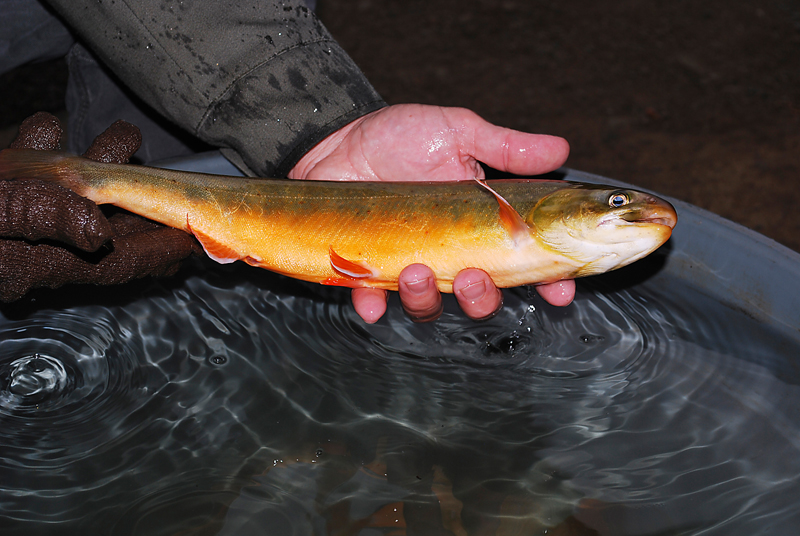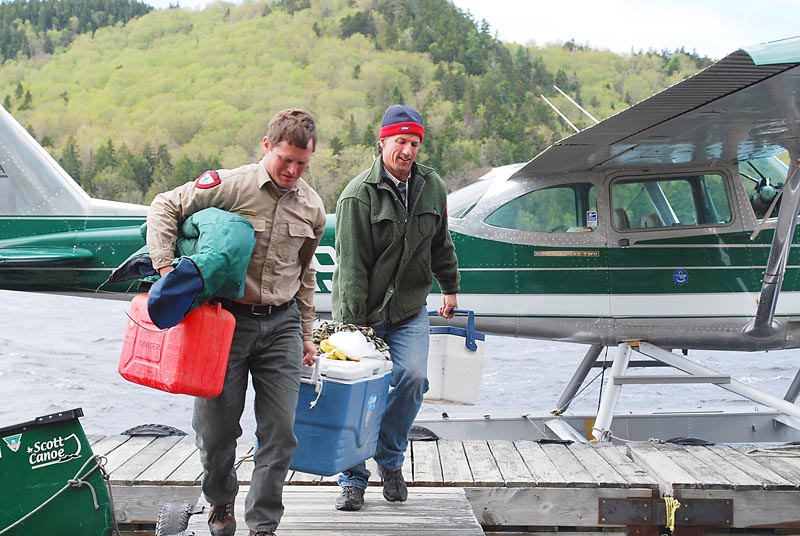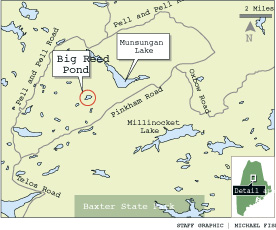TOWNSHIP 8, RANGE 10, WELS — To get from Big Reed Pond to Frenchville at the far northern tip of Maine requires a float plane trip to Munsungan Lake and from there a two-hour drive, most of that on logging roads.
It is a journey that state fisheries biologist Frank Frost has made on a regular basis for three years in an effort to restore one of Maine’s most uncommon species, the Arctic char. Until recently, Frost made the disjointed trek seemingly in vain.
Now the Department of Inland Fisheries and Wildlife biologist and several locals in the St. John Valley are celebrating the restoration of the char, northern Maine’s unique, threatened and much-loved game fish.
To say the Arctic char is native to Maine is an understatement.
The population in Big Reed Pond is one of the few that remain in North America since the last glacier retreated more than 10,000 years ago. It is one of 14 Arctic char populations in Maine and the only population in the lower 48 states.
Several years ago, however, rainbow smelt were illegally introduced into Big Reed Pond and decimated char numbers there.
Where fly fishermen once camped at the remote pond full of the brilliant orange char, the famous fishery now attracts none.
Then, three years ago, Frost began an ambitious project in hopes of restoring the wild Arctic char at Big Reed.
State biologists began trapping what char remained in the pond and bringing the fish to a private hatchery near Fort Kent with the hope the wild fish would spawn in captivity.
At Mountain Springs Trout Farm, Gary Picard slowly got the wild char to eat hatchery food, grow stronger and finally spawn with great success last fall.
This spring, 1,150 fry just inches long are growing fast and are on track to be released back into the wild next spring.
Though tiny, the fry collectively are an enormous symbol of success.
The Arctic char is listed as a species of special concern in Maine, and if the Big Reed population were lost, Frost said it could trigger a federal review that would put the char under consideration for an endangered-species listing.
Finally, after three years, Frost is confident that won’t happen.
“When we first started, nobody thought we’d pull it off because of the logistics. And I would be in that group. The pond is very remote and very difficult to get to,” Frost said as a huge smile crossed his face. “I’ve come 180 degrees.”
PRISTINE SETTING NEEDED
The forestland around Big Reed Pond is seemingly unending, a no man’s land where juvenile moose stare at trucks on what dirt roads exist.
There is no road to Big Reed Pond, just a lightly used trail.
The forest directly beside the pond is the largest remaining old-growth forest in New England, a jewel of The Nature Conservancy.
Arctic char require such pristine waters. The ancient fish can thrive alongside brook trout but not alongside many other species, such as smelt.
Two field biologists contracted by Inland Fisheries and Wildlife are living in a rustic cabin at Big Reed Pond to try to catch the remaining wild char there. Mostly, they catch only smelt, dozens of them.
Since 2007, just nine wild char have been caught in the pond by biologists, the ninth having been netted May 3.
Nobody knows how many remain. But the fact those caught were small, skinny and in poor health is a bad sign.
A Caribou native, Frost relishes the chance to change that.
“I think a lot of people in the state know about them or have heard about them. They have a mysterious mystique, especially with the color of the fish, the brilliant orange,” Frost said. “They just glow. They’re almost fluorescent.”
RESIDENTS CROSS FINGERS
Despite winning two Maine Outdoor Heritage Fund grants totaling $33,504, success came slow to the Arctic char project. But as willing partners joined, many just volunteers, Frost said it gained momentum.
Igor and Karen Sikorsky, owners of The Bradford Camps on nearby Munsungan Lake, offered to fly in supplies and fly out what char were caught at Big Reed Pond.
Igor Sikorsky said they have a stake in the project, as a robust wild char population would again draw fly fishermen to their remote cabin at Big Reed, part of Bradford Camps. The Sikorskys also value this pristine and open part of Maine.
“We hardly use this cabin at all now because there is zero fish. Last year, we had two guests stay on Big Reed Pond. In the mid-’90s, this was a must-go-to place,” Sikorsky said, standing beside the bare, 60-year-old cabin at Big Reed.
“We are the fifth owners of this camp since 1890. That’s pretty amazing. I may be here another 25 years, I may be here until I die,” he added.
The char project has been a mission of hope for many in Aroostook County, most of all for Picard, the hatchery owner who figured out how to keep the char alive.
“We’re very, very lucky he has given his time,” Sikorsky said of Picard. “He is also passionate. He was going out digging up grubs for the fish to eat.”
RECIPE FOR SUCCESS
Beside the St. John River 90 miles north of Big Reed, wild char transported to Picard’s hatchery have grown fat and feisty.
It’s a success story Picard is proud of, having figured out with Frost how to get the char to take hatchery food. The switch in diet, made a year ago, was critical because the processed food is loaded with protein, and the char were not growing.
Since last summer, the char have grown as much as 6 inches.
Now eight char 15 to 20 inches in length dart through a tank looking for free handouts. When the door to the tank room opens, the fish move toward it.
But Picard assures observers the fish are still wild.
“The first measure of success was that we got them here, and kept them alive,” he said.
Next spring, after a natural substance, rotenone, is applied to Big Reed Pond to kill the smelt, the char will be returned to their native waters.
The five-year project will prove worthwhile, but Picard said it’s not just about saving the char in Big Reed. The work done there will assure the species’ survival elsewhere in Maine.
“We’ve come up with a formula for how to get it to spawn (in captivity), so if other waters are threatened, we can replicate this process,” Picard said.
As it turns out, biologists recently discovered another population of char that are suffering after an introduction of rainbow smelt in Wadleigh Pond beside Chamberlain Lake.
Frost said there is less concern now, given the success at Big Reed Pond.
“It’s a big story. Their effort to capture these wild fish and keep them alive in a hatchery finally paid off,” said David Basley, the head fisheries biologist in Ashland and a 31-year veteran with the department.
“The Arctic char are a delicate species. It was all doom and gloom. Now that’s not the case.”
Staff Writer Deirdre Fleming can be contacted at 791-6452 or at: dfleming@pressherald.com
Send questions/comments to the editors.







Comments are no longer available on this story